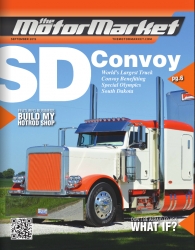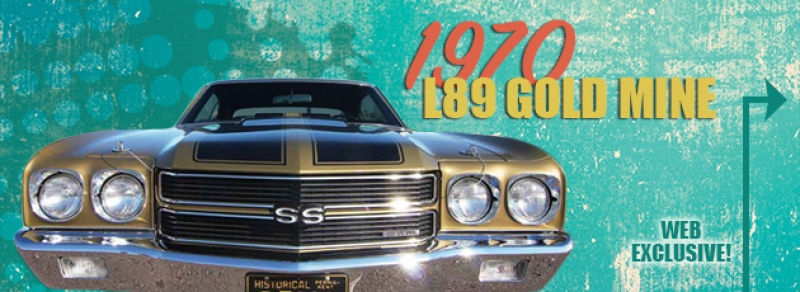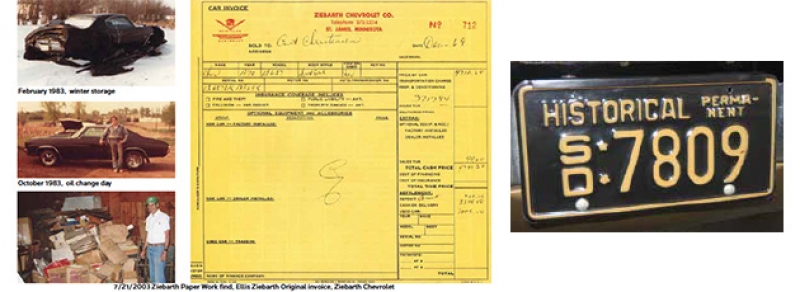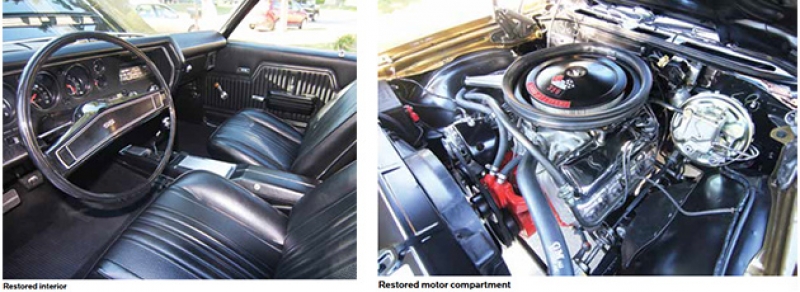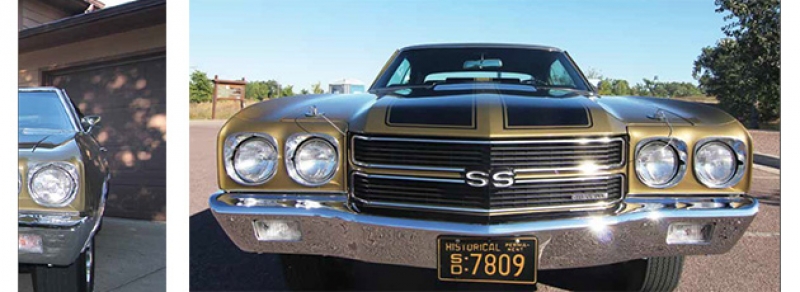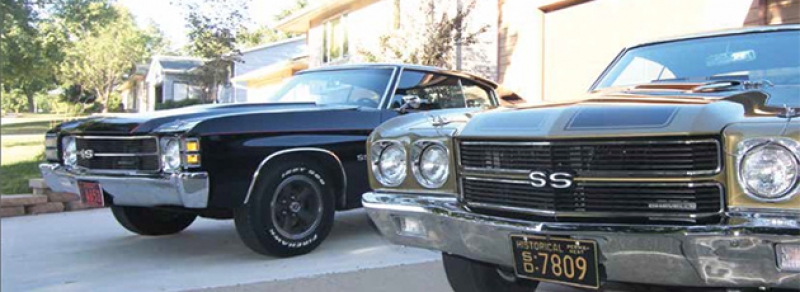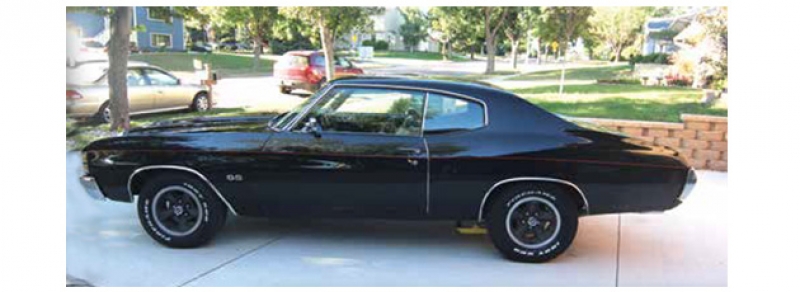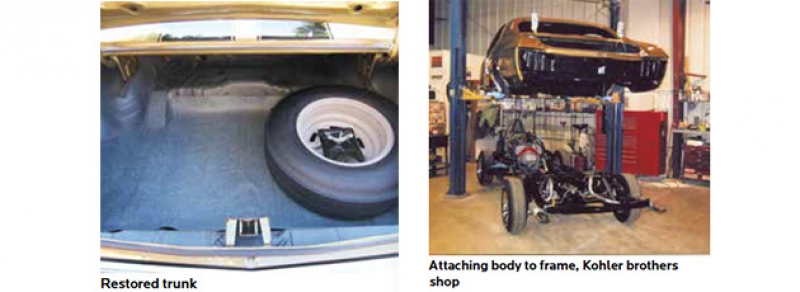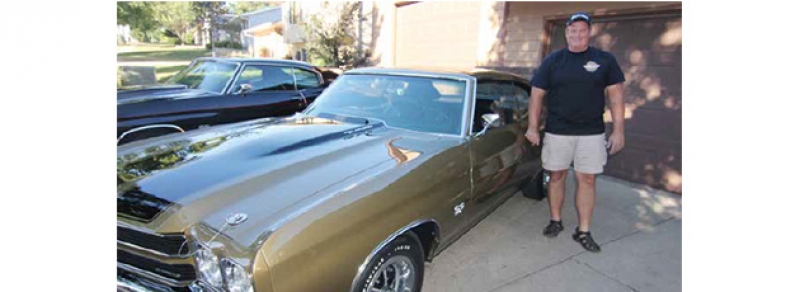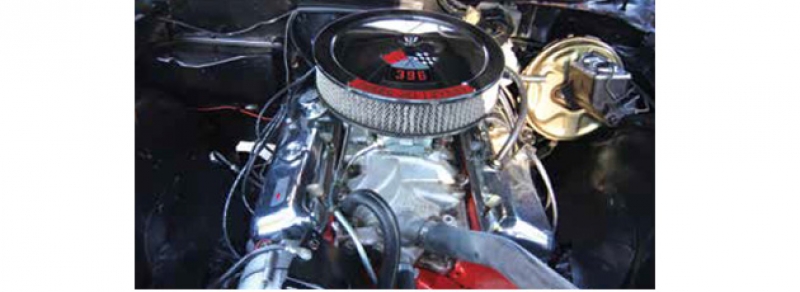More Issues
- August 2023
- September 2021
- August 2021
- July 2021
- June 2021
- May 2021
- April 2021
- March 2021
- February 2021
- January 2021
- December 2020
- November 2020
- October 2020
- September 2020
- August 2020
- July 2020
- May 2020
- April 2020
- March 2020
- February 2020
- January 2020
- December 2019
- November 2019
- October 2019
- September 2019
- August 2019
- July 2019
- June 2019
- May 2019
- April 2019
- March 2019
- February 2019
- January 2019
- December 2018
- November 2018
- October 2018
- September 2018
- August 2018
- July 2018
- June 2018
- May 2018
- April 2018
- March 2018
- February 2018
- January 2018
1970 L89 Gold Mine
Web ExclusiveLiving a Teenage Dream
“Wow, look at that car.”
“ Yeah, it looks perfect. Imagine what it took to restore it
like that…”
“That paint job is perfect.”
“And the interior looks brand new.”
“That motor sure is clean. All the numbers match too.”
“And those heads…are they…aluminum?”
“Do you know how rare this car is?”
“No…weren’t there a lot of these L89s produced?”
“Guess again. That’s one of the rarest L89s in the world.”
“I had no idea.”
No, this is not a real conversation this writer overheard at a car show. But it could be the typical conversation between two car enthusiasts standing in front of Brian DeJongh’s 1970 L89 Chevelle. The beautifully restored Chevrolet is one of the rarest Chevelles in the world because of one quirk in the motor. This car has aluminum heads. To understand the whole significance of this car, we need to go back in time about thirty-five years. It was 1979 in the small town of Luverne, Minnesota. There was a seventeen year old kid who was crazy about a car. Brian DeJongh had grown up in the quiet community where the most popular thing to do on a Sunday night was go drag race their cars after church. Though his first car was no slouch by anyone’s standards (it was a 1972 Chevelle), he had his heart set on the 1970 L89 Chevelle that was sitting beneath an oak tree. Maybe it was “love at first sight,” but after a test drive in the high performance driver in July 1979, his dad said, “Son, you are not going to own this car while you live under my roof. You will kill yourself in a high performance four speed car like this.” Brian was seventeen years old at the time. Instead of giving up on his dream, Brian continued to keep his eye under the oak tree.
“I loved that car so much. I was nervous because a lot of other guys in town wanted to buy it too. It was a great looking car. It had big Trac Action M 50s on the back and L60s on the front. But I would go down and brush the leaves off of it and make sure it was taken care of. I didn’t even own the car at that time,” said DeJongh.
He endured a summer of agony, sure that one day he was going to drive by and the car would be gone. Yet DeJongh’s luck held, and on November 14th, 1979 the car became his. It was Brian’s 18th birthday. For $850, he became the new owner of the car he had dreamed of for so long. After Brian bought it and got it running well, he took it out for the first test drive. He took it to the edge of town and laid two big blackies all the way out of the city limits. Life was good.
When Brian’s dad came home and saw the car sitting in the driveway, he was not happy. He asked, “Did Mom sign for it?” Dejongh said, “No, I’m 18 and I bought it myself.” The first day he had the car; Brian could not get it running. As it happens, a wire had shorted out on the header. A friend finally told him how to fix it, and a few weeks later he was a regular on the drag racing rind. The car wheel hopped so dramatically, DeJongh had to put Lakewood traction bars on it. After they were installed, the car would squat, bite the pavement, and take off. According to Brian, he learned how to be a good four speed driver from that car.
After two weeks of owning the car, Brian pulled out the original build sheet for the L89 from under the back seat. It read, “L78 396 4BL HC ENG/L89 ALUM CYL HEAD.” Not only does he have the original build sheet, but he also has nearly every other document relating to the car. In his words, “I have kept
everything.” Pro-tect-o plate, service work records, original dealer log book, original title transfer sheets, transfer papers from moving the car from Minnesota to South Dakota in 1983.
The car was ordered in September of 1969 at Ziebarth Chevrolet, in St. James, MN by Kurt Christensen. He wanted chrome valve covers on the motor, but Virgil Ziebarth mistakenly checked the aluminum head option on the order sheet. When the car arrived at Ziebarth’s dealership on November 25th 1969, it cost $200.00 more than expected because of the L89 option. Kurt and Virgil decided to split the difference. So the L89 Aluminum head option was initially a $200 mistake! In 1975, the car was bought by Kevin Olsen from New Ulm, Minnesota. He traded it to Conklin Auto in Winthrop, Minnesota in 1977, and credited his sale to them on a motorcycle.
In 1977, Kevin Strempee bought the car from Conklin Auto. He rebuilt the motor at Pipestone Area Vo-Tech while going to mechanic school. Shortly after graduating, he landed a mechanic job at Connell Chevrolet in Luverne, Minnesota. While working there, a guy from Sioux Falls traded in a ‘78 yellow corvette. He traded the 1970 Chevelle in on the Corvette. In March of 1979, Mike Reese bought the car from The Connell Chevrolet’s used car lot. He owned it from March
to November, as the Chevelle sat under a giant oak tree near Mike’s house. Brian bought it for $850 cash on his birthday on November 14, 1979.
During Brian’s senior year of high school, he and his friend worked together to restore their 1970 Chevelles. They spent the winters of 1979-80 rebuilding the cars near Hardwick, MN, at Arlyn Van De Kamp’s farm. In 1981 Brian pulled out the car. In his words, it was his “Good Driver car,” a.k.a. the date night car.
When Brian purchased the car, it was Autumn Gold with black stripes. Still he wanted to paint it “Midnight Metallic” bronze with gold stripes. After the car got its new paint, DeJongh drove it, got married, and then stored it. As per usual when life changes in a big way, the car went on the back burner. After being in storage for ten years, Brian decided in 1991 that it was time to restore the car again. This time he chose to paint it black with white stripes, and dolled up the inside with a brand new pearl white interior.
Brian drove the car in that condition until about 2001, when he had the revelation to put all the stock parts back on the car and restore it to its original glory. He chose to do a frameup restoration where every piece on the car was refurbished. The labor of love took ten years to complete.
The restoration began at Body Works by Dose where they stripped the car down to the frame, with Brian’s assistance. Next the car was put on a rotisserie body
rack, and any parts that needed welding were repaired. Every single piece was sandblasted, soda blasted, or bead blasted and then refurbished.
Such an intense restoration meant that Brian looked to outside sources for help in getting the car in perfect condition. Kohler Brothers handled the bodywork on the car, with the assistance of Mark Balzevich who worked with them at that time. Brian was very pleased with how the work turned out.
“After taking the car to Kohler Brothers, everything on that car was straight as a string,” said DeJongh.
After taking some time off to build up the cash reserves again, Brian took the Chevelle to Byron Dose at Body Works by Dose for the paint job. Other than the body work and paint, Brian handled all of the assembly of the car on his own.
How Rare Are We Talking?
In 1995, a friend of Brian’s called him with some interesting information in hand. Curt Johnson had dug into research after Brian told him he had the 1970 L89 Chevelle with aluminum heads. Friends always enjoy sharing good news, and did Johnson have some good news for DeJongh!
“He told me the car was one of eighteen vehicles ever made like this. So that definitely got me into doing my own research and digging into this documentation deeper,” said Dejongh.
As far as Brian knows, only one other 1970 L89 Chevelle with aluminum heads exists. However, this car is the only 1970 L89 Chevelle with aluminum heads that has full documentation. Brian went on the hunt for any and all documentation he could find about this car. His strategy in this was to strengthen the case that it was what the numbers suggested – an ultra-rare muscle car. His first strategy was to call Darrell Bowers, a local mechanic in St. James, MN. Bowers gave him the name of Donny Heller who had worked at Ziebarth Chevrolet in the 1950’s and 60’s. He put Brian in contact with Ellis Ziebarth, the son of Virgil Ziebarth, owner of the original dealership where the car was ordered. Ellis had worked for his father at the dealership, but moved to Upton, California in 1969.
When Brian contacted Ellis about finding paperwork for the L89 in July of 2003, Ellis said, “I have all of the Ziebarth Chevrolet Dealership documents and paper work in a building just outside of St. James, Minnesota.”
Brian immediately set up a time to meet with Ellis and arranged to purchase all of the documents from the dealership. The whole building was full of paperwork from November of 1944 to 1971. Brian took all the paperwork, and organized it. Essentially he purchased the entire paperwork history of Ziebarth Chevrolet for $300. It took him three trips to and from St. James to haul the many boxes of paperwork home in his truck. He remembers looking into the rear seat of his truck and watching mice scurry out of the boxes.
DeJongh spent many hours at his kitchen table sorting through boxes and boxes of records looking for ones that had the 1970 L89 Chevelle VIN numbers on them. His labor of love quickly paid off. After sorting through the entire record history of Ziebarth Chevrolet, he was rewarded with the car’s original invoice, protect-o- plate, service records, and original dealer log book. He also learned that the car was produced at the Leeds Factory plant in Kansas City, Kansas.
Brian drag raced the car in 1981, 1982, and 1983 at Thunder Valley near Marion, South Dakota. The car ran a 14.10 quarter mile, with minimal modifications. According to DeJongh, it is a miracle that the car was never wrecked or totaled. He hinted that there were many occasions where it could have been possible…
“We nearly totaled out the car on a road outside of Luverne one time. After a close call, my friend said, ‘Nice driving Bri.’ I also put it into a cornfield one time and just missed a telephone pole and corner post by inches. Thankfully there was no frame damage or body damage from those incidents,” smiled DeJongh.
The Final “Frame-Up” Restoration
DeJongh had done two paint and body restorations on the L89, but after learning of the rarity of the car, he made the decision to undertake a full, “frame off” restoration. This meant he needed to put all NOS or correct parts back on the car, including the correct dates and numbers. According to Brian, a couple of those parts were harder to find. He employed his most stealthy eBay and networking skills to find the correct aluminum heads. Those were a major challenge because of the rarity of the car and of the year the heads were produced. Before DeJongh purchased the Chevelle, the motor had been blown up, therefore the heads were missing. Still Brian was committed to doing a comprehensive, correct restoration. So he vowed to settle for nothing less than dated, numbered heads that were nice, original, and aluminum. It took three years to fulfill that vow. After years of searching, he discovered the correct dated, unmolested, stock, 842 closed chambered heads. Thankfully Brian had many of the other original parts left over from the first restoration he did during his senior year of high school. Those included the rear end, transmission, and block.
This frame up restoration was not the type of situation where the owner sent the car off to be restored and it came back to his garage looking perfect. Brian was involved in every aspect of this process.
“I put every piece on that car. Byron Dose and Dennis Kohle helped me assemble some things, and Carlyle Hartlieb helped a good bit too. Others who were involved in the restoration were the Kohler Bros., Dennis and Murray Kohler. We spent a lot of time in the Triple A refrigeration building in Tea,” said DeJongh.
Lovingly nicknamed the “Monster Garage,” they assembled the car in the warehouse near Tea. You would think such a painstaking restoration would be frustrating in itself. Imagine the level of angst when random things go very, very wrong.
“I had to do everything twice, if not thrice on that car. It fought me the whole way,” said Dejongh. “For example, we were out at the Monster Garage and there was an L-bracket holding a light above the car. For some reason the bracket gave way and dropped right on top of the car. I had just had it completely painted, and it left a dent and scratch on the top of the car. We had to redo the whole back half of the car. I had to redo the whole motor twice too,” recalled DeJongh.
“Anything With a Motor”
Motors have always been intriguing to Brian. He began working on motors when he was twelve years old with friend Mark Connell in their hometown of Luverne, MN. The first motor he ever took apart was a two horse Briggs and Stratton motor that was off a washing machine. The two friends built wood go carts together, and then wanted to work on something motorized. The next step was riding lawn mowers, then go karts, on to mini bikes; they loved to work on anything motorized.
Things have not changed much for DeJongh. He is in the process of working on another restoration project. It is a 1971 (numbers matching) SS 402 4 speed Chevelle, and he plans to drag race this one at Thunder Valley. When Brian was restoring the L89 car he knew he couldn’t drive it on the street. So he bought the ‘71 out of Pennsylvania after finding it on eBay. He plans to restore and paint it this winter.
“For me, it has always been the Chevelles. When I was a kid, they were the cars that always sparked my interest. I think they are good cars, mid-sized, versatile, and fast. We had quite a few Chevelles around Luverne when I was growing up,” said Dejongh.
When asked which car would he would love to own in the future, he quickly answered, “A 1970 440 ‘Cuda with a pistol grip shift in yellow with a black vinyl top.” Though DeJongh is a Chevy guy, he would still love to own a ‘Cuda. He claims the obsession started when he went for a ride with a guy who had one of those cars. Brian claims he was the self-confessed “car guy” in his hometown.
“I like all cars. Any brand that is a muscle car,” he said.
True to his word, Dejongh drag raced a ‘66 GTO for his brother one summer. He also drove a ‘70 Judge for his brother.
Starting a New Chapter
Here is a quick recap of what you have read thus far:
• The rarity of the car means it is one of eighteen ever made. However it is the only one remaining that is restored to such a degree with all original documentation.
• The car was ordered by mistake. Kurt Christensen , the original owner, wanted chrome valve covers rather than aluminum heads. Virgil Ziebarth Checked the L89 Aluminum Cylinder head box on the order form thinking this was the chrome valve cover option.
• The biggest decision of the entire restoration was discovering the best color for the car. The big question: paint it black again or go with the original Autumn Gold color?
In 1968-70, the aluminum head option was considered the high performance option. Then in October of 1969, Chevrolet discontinued the L89 Aluminum Head option. In December of 1969, Chevrolet released the LS6 450 horsepower Chevelle. That model dominated the market as the new high performance option. Kurt Christensen ordered the car in September of 1969. The aluminum head option was discontinued in October. Yet, the car was built in November. It was the last 1970 L89 Chevelle with aluminum heads to be produced in the world.
